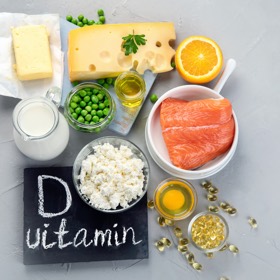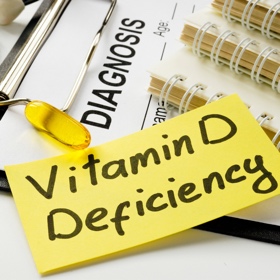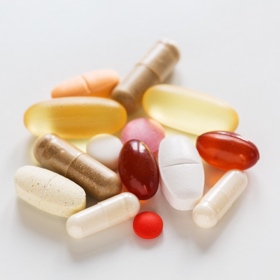Shining light on Vitamin D
The importance of vitamin D for good health,
by Valeria Frank, Resident Acupuncturist and Registered Associate Nutritionist (ANutr) at Shine, Newington Green.
 As we enter the winter months and the year closes, we take the opportunity to discuss some facts about Vitamin D. 2022 marks the Centenary of the investigation that showed cod-liver oil supplementation prevented or cured rickets in post-war malnourished children, when British microbiologist Dame Harriette Chicks made this landmark nutritional discovery in Vienna in 19221.
As we enter the winter months and the year closes, we take the opportunity to discuss some facts about Vitamin D. 2022 marks the Centenary of the investigation that showed cod-liver oil supplementation prevented or cured rickets in post-war malnourished children, when British microbiologist Dame Harriette Chicks made this landmark nutritional discovery in Vienna in 19221.
Around the same time, simultaneous investigations in the wider scientific community found that exposure to ultraviolet (UV) light in sunshine was also effective in preventing the disease1.
The (hormone-like) sunshine Vitamin
Vitamin D is synthesised through the action of sunlight on the skin, and subsequently converted in the liver (into the circulating serum 25-OHD or D3) and in the kidneys (into 1,25-dihydroxyvitamin D). Among its main functions, it supports intestinal calcium absorption, phosphorous homeostasis, and skeletal re-mineralisation2. Over the decades, evidence of Vitamin D’s action as a “pro-hormone” has also emerged, its role extending to effects on muscle function, fertility, the immune system, and skin health3. During the recent pandemic several studies linking Vitamin D deficiency and COVID-19 infection risk received wide media coverage4.
How do I get it?
The UK Recommended Nutrient Intake (RNI) for those aged above 4 years is set at 400 IU/day (10 micrograms/day). For younger children there are no RNIs, so the ‘safe intake’ is used instead (defined as the amount considered enough for almost everyone): between 340-400 IU/day for newborns to 1-year olds, and of 400 IU/day for 1 to 4 years old2.
 Dietary sources of Vitamin D include shiitake and fortified mushrooms, oily fish (salmon, sardines, herring, and mackerel), meats and liver, egg yolks, some fortified foods and breakfast cereals. Typically, only around 100 IU/day (2.5 micrograms/day) is achieved dietarily, from either fungi, plants (ergocalciferol, D2) or animal derived (cholecalciferol, D3) sources5.
Dietary sources of Vitamin D include shiitake and fortified mushrooms, oily fish (salmon, sardines, herring, and mackerel), meats and liver, egg yolks, some fortified foods and breakfast cereals. Typically, only around 100 IU/day (2.5 micrograms/day) is achieved dietarily, from either fungi, plants (ergocalciferol, D2) or animal derived (cholecalciferol, D3) sources5.
Deficiency is common
Signs of Vitamin D deficiency include weak muscles, aching bones, sleep cycle disturbance, hair loss, fatigue, and low mood, among others. With all the UK above 37°N latitude there is insufficient ultraviolet radiation in winter months, supplementation for the general population is recommended between October and March. In addition, those at risk of deficiency should have all-year round supplementation2. This includes pregnant and breastfeeding women, people aged under 5 or over 65 years, and those with decreased sunshine exposure (for cultural or health reasons) or absorption (due to darker skin pigmentation, limited physical activity, lack of fish and dairy consumption or an elevated BMI). More recently, teenagers have been identified to be at higher risk of deficiency5,6.
 The UK general population uptake of the national recommendations is poor: around 16% of 19-64 years old are deficient in Vitamin D. Furthermore, adults of Asian, Black African and Black Caribbean have lower mean Vitamin D status that white people7, as people with darker skin are less efficient at synthesising Vitamin D, and they need longer sunlight skin exposure to make the same amount of Vitamin D as those with paler skin. There are also renewed calls about the importance of supplementation among children, particular of those infants from Asian families who are found to be at higher deficiency risk compared to other groups5. UK routine deficiency screening is not recommended except for those considered at higher risk7.
The UK general population uptake of the national recommendations is poor: around 16% of 19-64 years old are deficient in Vitamin D. Furthermore, adults of Asian, Black African and Black Caribbean have lower mean Vitamin D status that white people7, as people with darker skin are less efficient at synthesising Vitamin D, and they need longer sunlight skin exposure to make the same amount of Vitamin D as those with paler skin. There are also renewed calls about the importance of supplementation among children, particular of those infants from Asian families who are found to be at higher deficiency risk compared to other groups5. UK routine deficiency screening is not recommended except for those considered at higher risk7.
Right levels?
There is notable variability (and heated discrepancies of opinions) between international thresholds for Vitamin D deficiency and supplementation:
• The UK Department of Health2 sets Vitamin D levels by blood serum results: deficiency for people with <25 nmol/L, insufficiency between 25-50 nmol/L, and adequate levels above 50 nmo/L. The 400 IU/day recommendation was set up as the intake that would prevent severe Vitamin D deficiency (<25 nmol/L) for most of the adult population (97.5%)2, and critics argue that these are very conservative, not sufficient to improve deficiency, calling for changing to more optimal supplementation levels for maintenance8.
• For the US National Institute of Health8 and for the European Food Safety Authority9, population deficiency risks are at <30 nmol/L. Their recommended supplementation is slightly higher, 600 IU/day to meet the needs of around 97% of all healthy adults and the upper safe limit of 4,000 IU/day.
• However, the US Endocrine Society10 considers blood serum 75 nmol/L to be more optimal levels for general health while advising 1,000–2,000 IU/day intake for maintenance. For obese patients that amount trebles, incrementing to 10,000 IU/day for chronic diseases and for cancer. To support reproduction, higher blood levels (around 75-100 nmol/L) may be needed.
 There is also wide variation in the amount of vitamin D found in supplements, ranging between 400 IU/day to 4000 IU/day or even higher. Toxicity from excess is rare, ingesting large amounts (50,000 IU/day) of Vitamin D supplements for a long period of time and without medical supervision, has reportedly caused high blood calcium levels considered dangerous (hypercalcemia) and renal failure11. For those taking multiple over the counter products containing Vitamin D, it is advisable to be aware of possible over-supplementation. On the other hand, it is safe to take a supplement while having a Vitamin D rich diet and spending time outside in the sunshine.
There is also wide variation in the amount of vitamin D found in supplements, ranging between 400 IU/day to 4000 IU/day or even higher. Toxicity from excess is rare, ingesting large amounts (50,000 IU/day) of Vitamin D supplements for a long period of time and without medical supervision, has reportedly caused high blood calcium levels considered dangerous (hypercalcemia) and renal failure11. For those taking multiple over the counter products containing Vitamin D, it is advisable to be aware of possible over-supplementation. On the other hand, it is safe to take a supplement while having a Vitamin D rich diet and spending time outside in the sunshine.
Take home messages
• If you are concerned about Vitamin D deficiency or are in an at-risk group, please seek advice from a medical professional, registered dietician, or nutritionist.
• Breastfed infants may need Vitamin D drops from 1 month of age if their mother has not taken Vitamin D supplements throughout pregnancy, as their Vitamin D status is largely determined by the mother’s levels.
• All children aged between 6 months and 3 years are advised to take Vitamin D drops, except those infants taking at least 500 ml/day of fortified infant formula. Toddlers’ formula milk is not routinely fortified, so please check the label. Please see www.healthystart.nhs.uk/getting-vitamins/
• Some fish liver oils, and some supplements can have too much Vitamin A, which should be avoided by groups such as pregnant women, so choose supplements tailored to your age group and condition.
• Vitamin D is fat soluble, so if you take your supplement in a capsule form (rather than in an oily medium such as sprays or drops), have them alongside some fat containing foods (oils, nuts, avocado).
 • Research from The Vitamin D and Sunlight team at The University of Manchester recommends the ‘little and often’ approach to sunlight exposure, balancing Vitamin D production with risks of skin cancer12: for people with lighter skin, daily sunlight exposure on unprotected skin for just 10-15 minutes during the spring and summer months (in the middle of the day, with exposure of lower arms and lower legs) and for people with darker skin, 25- 40 minutes of exposure under the same conditions. Pink or sunburnt looking skin should be avoided by lowering the unprotected time spent in the sun. People with very sensitive skin should seek further guidance from their doctor.
• Research from The Vitamin D and Sunlight team at The University of Manchester recommends the ‘little and often’ approach to sunlight exposure, balancing Vitamin D production with risks of skin cancer12: for people with lighter skin, daily sunlight exposure on unprotected skin for just 10-15 minutes during the spring and summer months (in the middle of the day, with exposure of lower arms and lower legs) and for people with darker skin, 25- 40 minutes of exposure under the same conditions. Pink or sunburnt looking skin should be avoided by lowering the unprotected time spent in the sun. People with very sensitive skin should seek further guidance from their doctor.
• Examples of foods amounts and Vitamin D content can be found here.
• This podcast from Zoe Science and Nutrition, discussed supplements, a recent Vitamin D trial and dosages
Valeria Frank MSc (Human Nutrition), BSc (Hons) TCM Acupuncture
Valeria has been a resident acupuncturist at Shine on The Green since 2009, specialising in fertility and IVF support, Women’s health and pregnancy acupuncture. She is also a Registered Associate Nutritionist (ANutr) and for her Masters’ degree thesis she investigated the Vitamin D status and lifestyle characteristics of over 1,100 fertility patients.
References
1. Buttriss, J.L., & Lanham-New, S.A. (2022), Vitamin D: One hundred years on. Nutr Bull, 47: 282-287. https://doi.org/10.1111/nbu.12575
2. Scientific Advisory Committee on Nutrition [SACN] (2016). Vitamin D and Health. The Stationery Office. https://www.gov.uk/government/publications/sacn- vitamin-d-and-health-report
3. Bouillon, R., Manousaki, D., Rosen, C., Trajanoska, K., Rivadeneira, F., & Richards, J. B. (2022). The health effects of vitamin D supplementation: evidence from human studies. Nature reviews; Endocrinology, 18(2), 96–110. https://doi.org/10.1038/s41574-021-00593-z
4. National Institute of Clinical Excellence. (2020). COVID-19 rapid guideline: vitamin D (NICE Guideline). https://www.nice.org.uk/guidance/ng187
5. Buttriss, J. L., Lanham-New, S. A., … & Prentice, A. (2021). Implementation strategies for improving vitamin D status and increasing vitamin D intake in the UK: current controversies and future perspectives: proceedings of the 2nd Rank Prize Funds Forum on vitamin D. The British Journal of Nutrition, 1–21. https://doi.org/10.1017/S0007114521002555
6. National Institute of Clinical Excellence. (2022). Vitamin D deficiency in adults. Updated January 2022. https://cks.nice.org.uk/topics/vitamin-d-deficiency-in-adults/
7. National Institute of Clinical Excellence. (2014). Updated 2017. Vitamin D: supplement use in specific population groups. Public health guideline [PH56]. https://www.nice.org.uk/guidance/ph56
8. Institute of Medicine, Food and Nutrition Board. Dietary Reference Intakes for Calcium and Vitamin D. Washington, DC: National Academy Press, 2010. https://ods.od.nih.gov/factsheets/VitaminD-HealthProfessional/
9. European Food Safety Authority. (2016). EFSA NDA Panel on Dietetic Products, Nutrition and Allergies: Scientific opinion on dietary reference values for vitamin D. EFSA Journal, 14(10), 4,547, 145. https://doi.org/10.2903/j.efsa.2016.4547
10. Holick, M. F., Binkley, N. C., Bischoff-Ferrari, H. A., Gordon, C. M., Hanley, D. A., Heaney, R. P., Murad, M. H., Weaver, C. M., & Endocrine Society. (2011). Evaluation, treatment, and prevention of vitamin D deficiency: an Endocrine Society clinical practice guideline. The Journal of clinical endocrinology and metabolism, 96(7), 1,911–1,930. https://doi.org/10.1210/jc.2011-0385
11. Galior, K., Grebe, S., & Singh, R. (2018). Development of Vitamin D Toxicity from Overcorrection of Vitamin D Deficiency: A
Review of Case Reports. Nutrients, 10(8), 953. https://doi.org/10.3390/nu10080953
12. Burchell, K., Webb, A., & Rhodes, L. (2019). Sunlight exposure and vitamin D: Getting the balance right: sunlight exposure advice that ensures adequate vitamin D while minimising the risk of sunburn and cancer. https://www.research.manchester.ac.uk/portal/files/132402692/Briefing_Note_Sunlight_exposure_and_Vitamin_D_FINAL.pdf